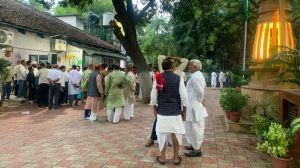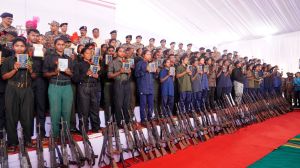The last bastions of Mandal
Their enemies were writing their epitaphs. Their fellow-travellers had ditched them and were hoping that they would burn out. Yet, despite a...

Their enemies were writing their epitaphs. Their fellow-travellers had ditched them and were hoping that they would burn out. Yet, despite all odds, Former Uttar Pradesh and Bihar chief ministers Mulayam Singh Yadav and Laloo Prasad Yadav have not only managed to survive but emerge as key players in the national arena after the 1998 Lok Sabha elections.
For both Mulayam and Laloo, it was sweet revenge when the emergent challengers to their hegemony within the third force stood isolated and marginalised by the people, leaving them as the sole bulwarks of secular forces in the Hindi belt. In UP, Bahujan Samaj Party supremo Kanshi Ram was defeated and the strength of his party in the Lok Sabha was reduced to almost half of what it was in 1996. In Bihar, Laloo Prasad himself trounced his bete noire, Janata Dal president Sharad Yadav.
More important, by registering not so insignificant gains in their respective fiefdoms, the two Yadavs have shown that if the Congress or any other party was to remain inbusiness in their strongholds, it will have to dance to their tunes.
Mulayam has been fighting alone ever since Kanshi Ram’s Bahujan Samaj Party, — which commands influence among the State’s 22 per cent Dailts — broke its logical alliance with the SP in 1995. This time even the UF constituents such as the Janata Dal and the CPI had fought against his men. But they could not stop his march.As the UP results show, the Samajwadi Party has not only bagged 20 Lok Sabha seats this time against 16 it had in 1996, but the vote share of his party has increased from 21 to 29 per cent. In most of the State’s 85 Lok Sabha seats, it was the SP which gave a fight to the BJP, relegating the BSP and the Congress to third or fourth places.
This is no mean achievement since the BJP has also, for the first time since it rode to power in UP on the Ram wave in 1991, increased its vote share from 33 per cent to 36 per cent.
That it could do so only at the cost of the Congress and the BSP shows that Mulayam will be theundisputed leader of any anti-BJP political formation.
The Congress was totally routed and its vote share dipped down to a mere 6 per cent and the BSP also appeared to have reached its peak with a vote share of around 20 per cent. Unless something unexpected happens,indications are that the BSP’s Dalit vote bank would also start slipping away from it, now that it can no more claim to be a serious contestant for power.
In Bihar, Rashtriya Janata Dal chief and former CM Laloo Prasad also blew up all poll predictions by putting up a spirited resistance to halt the the BJP-Samata juggernaut.
Laloo has demonstrated that his Muslim, backward and Dalit followers are unaffected by the charges of corruption and nepotism levelled against him by his detractors. After the fodder scam, Laloo had become an untouchable even for his former colleagues, but the results prove that the masses think that the "messiah" has not failed them.
Compared to the 1996 tally, the RJD and its allies have fallen short of only twoseats. His friends-turned foes in the Janata Dal who occupied six seats in the dissolved Lok Sabha got a severe battering at the hustings and had to pay a heavy price for the split. Among them, only Railway Minister Ram Vilas Paswan could make it to the 12th Lok Sabha. And he could do it only with the help of the BJP-Samata combine which did not field a candidate against him.
Election results in UP and Bihar clearly indicate that the Mandal forces representing a quest for power by upwardly mobile lower castes will continue block the RSS-BJP attempt to mobilise the people on communal lines. Any effort to forge a coalition of secular forces will, therefore, have to be centred on Laloo Yadav in Bihar and Mulayam Singh in Uttar Pradesh.
But the elections have also underscored the limitations of the purely caste-based alliances. It is a fact that despite their claims to the contrary, the brand of social justice Laloo and Mulayam represent is an elitist version of the politics of social justice.
Whileclaiming to defend the rights of the downtrodden, they have maintained a continuum with the political interests of the ruling classes, especially the big business and only sought to replace the Congress and the BJP as the number one ruling party within the same framework. This has made Mulayam befriend industrialist-politicians like Sanjay Dalmia and Amar Singh and Laloo lean on Haryana industrialist Prem Kumar Gupta.
How far can the social justice forces work as an effective counter-force to Hindutva? There is no doubt that the Mandal mobilisation and the bahujan politics have posed a stiff challenge to the Hindutva offensive. But the BSP’s honeymoons with the BJP in the past and the Samata Party’s alliance with it show that they are also prone to straying from ideology in the race for power.
Ready for bouts, always
Hailing from a marginal farming family of Sainfai village in Etawah district of central-west UP, Mulayam Singh Yadav was only 14 years old when he courted arrest in an agitationlaunched by socialist leader Ram Manohar Lohia. Since then, politics has remained his only obsession, though he has taught in a college and also participated in wrestling bouts.
Mulayam became a member of the UP legislative assembly in 1967 and has won all elections since then without break. While Laloo is colourful and low-profile, Mulayam has maintained a low-profile. But those who have taken him at face value and ignored or opposed him have lived to rue the day.
As the then Chief Minister of UP, Mulayam blocked the Vishwa Hindu Parishad bid to demolish the Babri Masjid in 1990, even at the risk of being branded Maulana Mulayam. Almost wiped out from the political map in the 1991 Ram wave, Mulayam bounced back to the centrestage of UP politics after 1993 elections when he headed a SP-BSP coalition government. But another jolt awaited when Mayawati pulled out and was propped up as the UP Chief Minister by the BJP. Since then, Mulayam has decided to fight on his own. And this time, he proved hecould.
The lone battle
Son of a class-IV government employee, Laloo Yadav was student leader in Patna when he joined Jaya Prakash Narayan’s movement in 1974. When he became the Chief Minister of Bihar in 1990, few expected him to last beyond a couple of months. But he has not only proved to be the longest-serving Chief Minister of the State but managed to hand over the reigns of power to his wife Rabri Devi when he could not hold on to it after his indictment in the fodder scam.
Now that Bihar is in the hands of his wife, Laloo is itching to take his battle to Delhi. The 1998 elections posed the stiffest political challenge in his life when his JD fellow-travellers dumped him and joined his enemies to remove him from the political map of Bihar. He took the challenge, and came out with a smile. "Like Arjuna, I am prepared to fight a thousand wars to defend the principles I stand for," he said after the results were out.






- 01
- 02
- 03
- 04
- 05

























